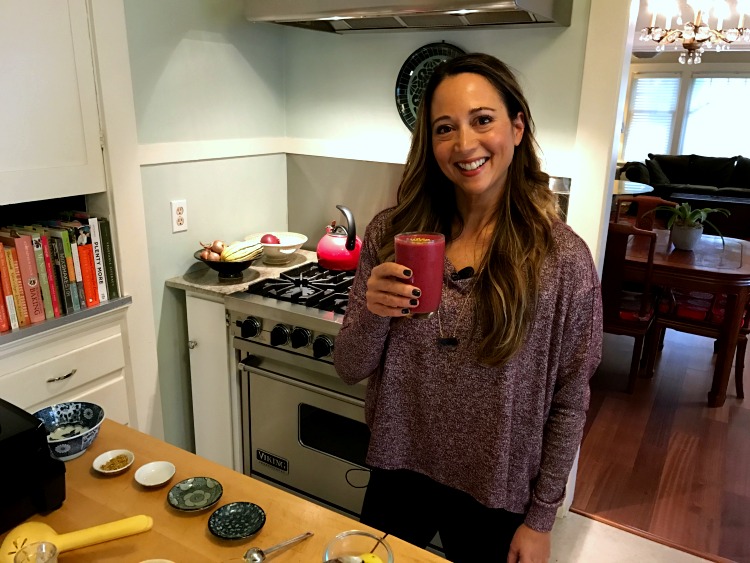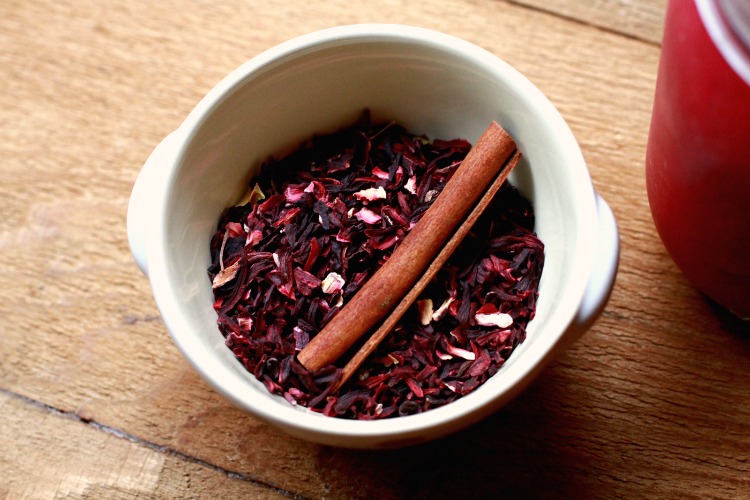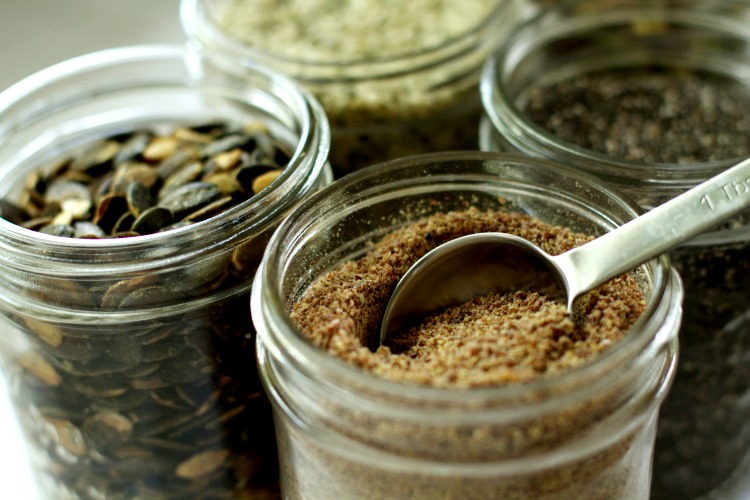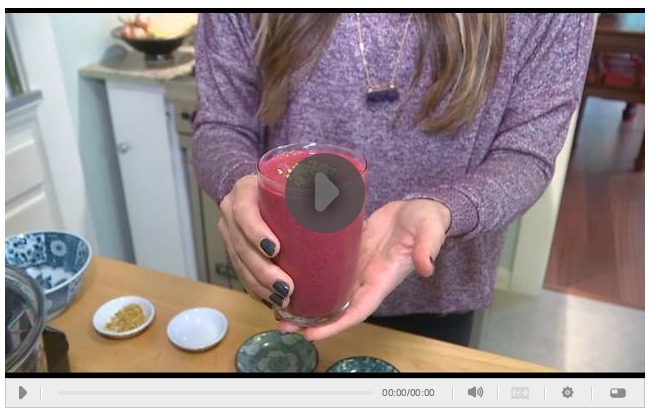This post on the Heart-Healthy Strawberry Smoothie post is available via audio.
To listen, just click on the link below. I created this special smoothie for a Go Red for Women event earlier this year.
Please click below to access the audio version of this post.
Let's imagine it's the just the two of us.
We've bumped into each other at the grocery store — and we get to talking. You consider hiding the salted caramel gelato in your basket, but then you see corn chips and a bottle of rosé in mine, so you figure — why bother? She's normal.
Phew — glad we got that out of the way early!
So we get to talking, and you tell me that you want to start getting back on track, and eating healthier meals. But you're stuck.
You say something like,
Eating healthy is so time-consuming.
Or… Eating healthy is so expensive these days.
Or… Healthy food doesn't taste as good as the other stuff.
Or… I can't eat healthy because my husband won't.
I nod my head in agreement — it can be all those things.
I say, “Yep, eating healthy can definitely be time-consuming and too expensive. It can also be bland or boring, and it's challenging when your family won't get on board.”
Now, the look on your face. You're surprised, then visibly bummed. Maybe you're feeling an odd mix of disappointment and relief. You think, well if even she can't make it happen, then… hello, take-home pizza!
Let's Keep Talking
Our grocery store conversation doesn't have to stop there. In fact, it shouldn't. This is just the beginning of a longer dialogue I'd love to keep exploring in the weeks and months to come.
Here's the thing: I know getting healthy food onto the table and into our bodies is challenging — many things in life are, but we figure out a way to do them anyway.
For example:
Finding an easier, faster way to commute to work? Challenging!
Shuttling your kiddos around to their sports or after school activities? Time-consuming!
Having fun clothes or going on vacation? Expensive!
All of these things add a bit of extra complexity to our lives, but you know what? We make them happen. We find a way. We get it done, because these things are important to us and those we love.
Which brings me back to the grocery store.
Acknowledging that healthy meal prep is challenging doesn't mean the conversation has to stop in its tracks, stalled out somewhere between the frozen burritos section and the cookies-and-crackers aisle. It's true, figuring out this whole healthy living thing does require some careful consideration and energy, but the payoffs are epic.
I'm talking about: the satisfaction you feel when you get the results from your annual exam and your cholesterol has gone down. And on top of that, your doctor says that your LDL/HDL ratio looks amazing.
Or, your blood pressure is finally within normal range.
Or, you can ditch the medication that has been giving you serious side effects.
You wake up in the morning, and you feel amazing without needing to get all jacked up on coffee. Your anxiety softens, and your moods even out. You lose some weight, and finally feel good and strong in your body.
Plus other people are noticing. They ask: is it a new haircut? Did you go somewhere sunny? Did you get botox?
No! You just figured it out, this healthy living thing, and you're reaping the benefits big time.
Start Small, Win Big
Eating healthy doesn't mean you have to change your whole routine — breakfast, lunch, dinner — overnight.
And you don't have to sign up for a detox or cleanse, although I'm here for you if that sounds like a good fit in the future.
The best way to start making this happen — for once, and for all — is to start small.
Here's why I like starting small.
Number one, it's realistic. Because you have a lot on your plate (so to speak!), and you don't have the bandwidth to go nuts right off the bat.
Number two: it's easy. And if something is easy, you'll find time to fit it into your schedule, even on the busiest of days.
Number three: it leads to bigger things, like eating healthy food more consistently — bite after bite, meal after meal, day after day.
Starting small may seem kind of un-American at first. After all, we live in the world of reality TV— Biggest Loser, American Ninja Warrior, Master Chef — where life-changing dreams are seemingly realized in a matter of mere hours, or minutes.
In comparison, starting small doesn't seem like a big deal. It may even seem, on the surface, like it's not enough. Like it's lame.
But it is enough.
Ask any of those reality show stars how they got to where they are today and they'll share that it all started with one push-up, or one time helping Mom in the kitchen, standing on a stool to mix cookie batter.
Starting small is more than enough. Because that one small, simple, unassuming healthy action will open doors and lead to much bigger things.

How to Start Small
Let's start with a few super-healthy ingredients, and with a recipe that doesn't take much shopping, prep, or time. And let's start with something that's both beautiful and delicious on the plate — or in a glass, as the case may be.
In other words, let's start with a smoothie.
Come on, I'll show you — by going back to that grocery store.
First, we walk over to the frozen foods, and I throw a couple of things into your basket. Then, we go over to the nuts and seeds, and pick up a couple more bags. Then, we grab a box of almond milk before heading over to the bulk foods aisle for something exotic, something that'll take this smoothie up a notch.
Uh, oh. I can tell you're worried about this last part: hibiscus petals and a cinnamon stick.
It's okay, I tell you. You're not going to believe how easy this is. It's not expensive, and it'll be worth it.
Because even though we're starting small, at least one part of our experiment needs to be special. It needs to be exciting, and different, so that the healthier part of us — the one who wants to make all of this happen — perks up and says, “well, hey now!” This makes her feel listened to, like her opinion matters. That she doesn't always have to be bullied around by the other part of you who's saying, healthy food is too expensive, time-consuming, challenging!
It's all going to work out, I say. It's going to take 30 seconds of advance prep tonight, but you're going to love it.

Heart-Healthy Strawberry Smoothie
Let's continue this fantasy just a little longer.
Now, we're in your kitchen. I just put your frozen stuff away, while you put the other ingredients on the kitchen counter so they'll be good to go in the morning.
We have in front of us a mason jar, and the hibiscus petals and the cinnamon stick.
First, I say, we're going to cold-brew some hibiscus tea.
I know. It sounds fancy. But I assure you it's not.
Step One: put hibiscus petals and cinnamon stick into the mason jar.
Step Two: Cover with water.
Step Three: Screw on a lid and put the jar in the fridge overnight.
Step Four: In the morning, strain out the solids, and you have a jar full of beautiful hibiscus tea. You'll use that as part of the base for your smoothie — and you'll have some extra for iced tea later.
Okay, now what you have your liquid base for your smoothie, let's keep going.
Heart-Healthy Ingredients
I created the Heart-Healthy Strawberry Smoothie for a Go Red for Women event earlier this year.
Now, you might be saying to yourself, “Aren't all smoothies heart-healthy?”
And you might be right, since smoothies are a great way to get more fresh vegetables and fruit into your diet. However, I chose three of the ingredients specifically for their heart-health superpowers. All three have been clinically shown to support healthy blood pressure…
Hibiscus Tea
In a PREMIER clinical trial, a cup of hibiscus tea with each meal didn’t just lower blood pressure by three, four, or five points, but by seven points, from an average of 129 down to 122. In fact, tested head-to-head against a leading blood-pressure drug, Captopril, two cups of strong hibiscus tea every morning (five tea bags for the two cups) was as effective in lowering blood pressure as a starting dose of 25mg of captopril taken twice a day. (Source, PREMIER clinical trial, via “Plant-Based Diets for Hypertension” on Nutritionfacts.org).
Flax Seed
If you've been following me for awhile, you know I'm a huge, huge fan of flax seed. In his bestselling book, “How Not to Die,” Dr. Michael Greger cites numerous studies showing flax seed's beneficial effects on hypertension (high blood pressure), including one that showed how ground flax seed was shown to drop subjects' systolic and diastolic blood pressure more effectively than leading medications, without side effects. Oh, and flax seed is good for reducing risk for breast and prostate cancer. Pretty amazing stuff, that flax seed.
Beets
If you're a runner, endurance athlete, or sports fan, you may have heard about professional and Olympic athletes using beet juice to improve their athletic performance. Maybe you've even heard about how athletes such as NBA star Dwyane Wade, US Olympic marathoner Shalane Flanagan, and even the Auburn football team have experimented with beets and beet juice in recent years.
This is because beets are a natural source of nitrates, which the body then converts to nitric oxide (NO), which is needed to dilate the coronary arteries that enable blood flow to the heart. In fact, a study published in the Journal of Applied Physiology in 2009 found that beet root juice improved endurance in test subjects by enabling them to utilize less oxygen during exercise, making their energy use much more efficient. I suppose that's all well and good for athletes, but what about regular people? Are there similar benefits? Yes, according to a study funded by the British Heart Association, which found that beet juice reduced systolic blood pressure by about 8 points among study participants, with a cumulative effect that showed improved results week after week. As a result, the study concluded that “nitrate-rich vegetables may prove to be both cost-effective, affordable, and favorable for a public health approach to hypertension.” Side Note: for a deeper dive, I highly recommend you check out Dr. Greger's book, How Not to Die. It's an amazing resource, that draws upon Dr. Greger's extensive research of the hundreds of peer-reviewed medical papers published each year.
So there you have it — a powerful trio of heart-healthy ingredients. It's time to pull them all together in one very special smoothie…
Watch the Video
I recently made the Heart-Healthy Strawberry Smoothie for my healthy living segment on the More Good Day Oregon show.
If you'd like a step-by-step demo, please click on the graphic below.
Get the Recipe
If you'd like the recipe for the Heart-Healthy Strawberry Smoothie, just click on the recipe link below.



